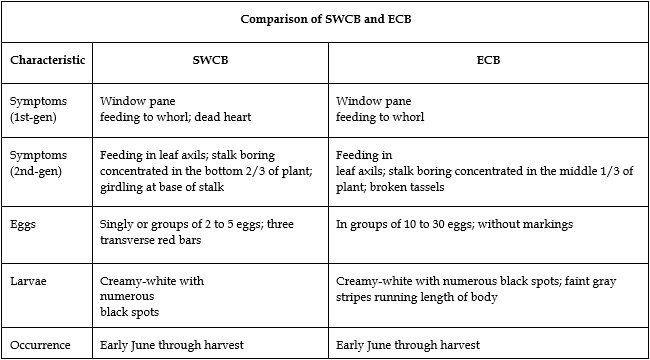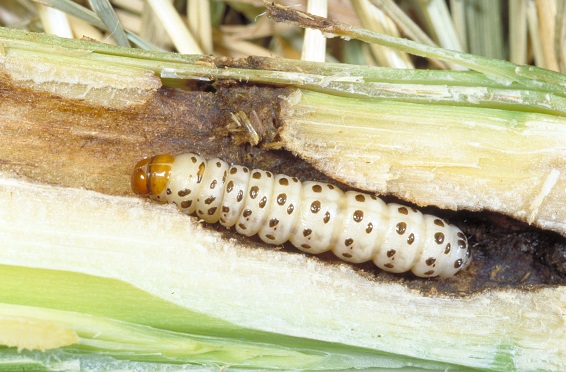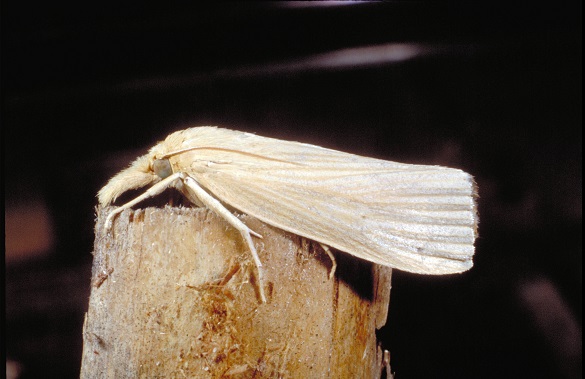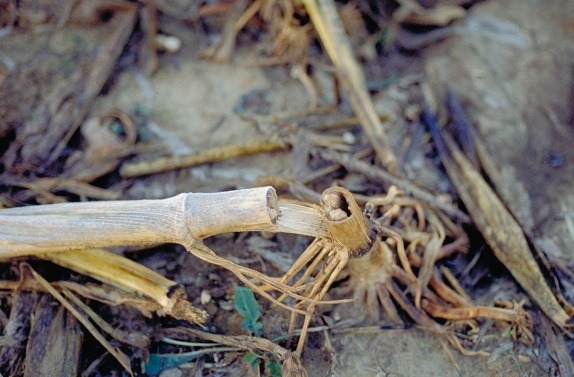Southwestern Corn Borer
ENTFACT-108: Southwestern Corn Borer | Download PDF
by Ric Bessin, Extension Entomologist
University of Kentucky College of Agriculture
During the late 70's it was regarded as one of the most serious insect pests of corn, but after more than a ten year period of not being reported in Kentucky, the southwestern corn borer (SWCB) has reappeared in Kentucky. Since 1992, the southwestern corn borer has spread across the western half of Kentucky and it distribution now extends east to Nelson and Pulaski counties.
SWCB Biology
While similar in biology to the European corn borer (ECB), the SWCB is the most difficult insect to control. The SWCB has two or more generations per year. The first generation attacks whorl-stage corn and is associated with losses to yield by stunting or killing plants. The second generation occurs during mid- to late summer and increases harvest losses through stalk breakage due to extensive tunneling In the fall, overwintering larvae increase plant lodging by girdling the base of the stalk.
Figure 1. SWCB has distinctive spots during the summer.
SWCB overwinters as creamy-yellow larvae in stalk base below the soil. The full grown larva is 1-1/4 inch. In the spring, pupation takes place in the stalk base. Dull white moths emerge from the stubble, mate, and deposit their eggs on the upper and lower surfaces of the leaves. Eggs are laid singly or in groups of 2 to 5, with the flattened eggs overlapping like fish scales. Initially eggs are greenish-white, but develop three distinct red transverse lines within 24 to 36 hours. Eggs hatch in 4 to 7 days.
Impact on Corn
First-generation larvae first appear in Early June. These summer-form larvae are milky white with a brown head and have numerous distinct brownish-
black spots on the body (the overwintering form does not have these distinctive spots on the body). For the first two weeks, first-generation larvae feed within the whorl of the plant. After feeding in the whorl, larvae move down the stalk and tunnel into the stalk. Numerous holes in the emerging leaves and leaf breakage due to midrib tunneling are characteristic. While leaf feeding may not lead to serious yield loss, destruction of the bud in the whorl can result in a "dead heart" and complete loss of yield by a plant.
Figure 2. Overwintering southwestern corn borer loses the distinctive black spots.
The second and third generations cause the greatest damage in Kentucky. These larvae begin feeding in the mid and lower zones of tassel-stage corn in mid to late July. Typically they feed between the layers of husk on the primary ears. After about two weeks, the larvae begin tunneling in the stalk. Unlike ECB, SWCB does not "wander" through the stalk. Characteristically they make a straight line through the middle of the stalk. In the fall, borers that will remain larvae throughout the winter migrate to the base of the plant and tunnel. These larvae often girdle the plant at the base before tunneling downward. This is the most serious damage caused by SWCB. Larvae girdle the stalk by chewing a complete or partial internal groove around the stalk near the base. This leaves only a thin outer layer of the stalk for support.

Figure 3. SWCB moths are without distinctive markings.
Management
Early Planting
Early planting, when practical, is generally the most efficient and economical method of preventing plant damage and yield losses to SWCB. However, wet weather frequently delays corn planting and increases the possibility of borer infestations. Corn planted after May 1 has a greater potential for SWCB infestations. Lower establishment rate by second- or third generation borers on older plants is the primary reason for early planting.
Similar to management of ECB, timing is critical for control. Larvae can only be effectively controlled while they are feeding within the whorl. Once they enter the stalk they cannot be controlled. Management of the SWCB relies on maintaining the first generation infestations below a 35% economic threshold. Controls aimed at the second generation are less effective and not economical.
Field Monitoring
Monitor fields in early June for initial shot-hole feeding to whorl leaves. If damage is noted while walking through the field, examine 20 consecutive plants for each of several locations within the field and record the number of plants with damage. Select the starting point for each location randomly. Pull out the whorls from 2 damaged plants from each sample to note if the larvae are still present in the whorl and determine if the damage was caused by SWCB or ECB. Controls should be considered for first generation southwestern corn borer if 35% of the plants show damage and SWCB larvae are still present in the whorls.
Fall-Tillage
No-till corn production has increased substantially in the 20 years since a serious SWCB outbreak. Prior to this change in corn production, control recommendations for SWCB included deep tillage, and destruction of corn stubble. However, in the scope of current soil conservation practices, this is not an option. Producers need to be aware of the potential problem with SWCB, particularly in no-till corn, and use field monitoring during the growing season and after harvest to base management decisions.
Figure 4. SWCB late season damage results in stalk lodging.
Bt Corn Hybrids
Currently, the above-ground Bt traits provide the full-season control needed to prevent the stalk girdling caused by the overwintering SWCB larvae. For a listing of available insecticides, use those listed for the European corn borer in ENT16, Insecticide recommendations for field corn.
Revised: 11/19
CAUTION! Pesticide recommendations in this publication are registered for use in Kentucky, USA ONLY! The use of some products may not be legal in your state or country. Please check with your local county agent or regulatory official before using any pesticide mentioned in this publication.
Of course, ALWAYS READ AND FOLLOW LABEL DIRECTIONS FOR SAFE USE OF ANY PESTICIDE!
Photos courtesy Ric Bessin, University of Kentucky Entomology




